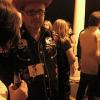The Dance Film Project and art on video
Editorial
Tonight will be the last presentation of this year’s “Dance Film Project,” organized by the Cinema Revolution Society, and it’s an interesting exercise in creating a cross-discipline work. In fact, in an especially interesting experiment, regardless of what discipline you’re in, because there has been a movement toward creating short video examples of work and having them available on the Web -- this has become increasingly common in theater and stand-up comedy.
But this creates some perplexing problems. Because, when you transfer something that’s created for one medium -- live performance -- to another medium -- short film -- there are all sorts of questions that must be answered. With our example here, dance, there is the question of how you represent it. We’ve been seeing a lot of dance on film and television lately, a a lot of it bungles the question quite badly. The dance will be chopped up through edits, so the audience only gets a sense of movement, not a sense of the performance as a whole. Fred Astaire’s solution to this was to set up a camera in the middle distance and let it roll, with minimal movements or edits, but this is only one solution. Gene Kelly favored more dynamic use of the camera, with it swirling and swooping like an additional partner in the dance.
This is the exact question the participants in the Dance Film Project were tasked with answering. The language of the project, specifically, said “For dance for the camera, the dance and film/video elements are both integral to the final product. Rather than creating a film/video presentation of a staged performance, each project is to consider how to combine the forms in a new and unique way.” You can, in fact, see some examples of how dancers and filmmakers have addressed this question online -- there are past examples of projects from the project on Youtube, such as “Fabled," a collaboration between filmmaker Todd Wardrope and the We Dance collective. I suspect in this instance the dance was specifically conceived, or re-conceived, for the screen, as it has multiple edits and changes of location, none of which affects the sense of the dance as being a complete piece.
If you’re creating a film to put online as a preview of a live performance, as in theater, or a sample of your work, as stand-up comics do, then you’re faced with another question: How do you retain the flavor of a live, onstage performance without just setting up a camera and filming a live performance, which often feels oddly flat, and can suffer in other ways. Stage lighting might look unreal on camera, the style of performance that works onstage might seems excessive on film, and works transferred to film tend to benefit from having a deliberate cinematic quality to it -- intelligent edits, deliberate camera movements, etc.
One last thing: The Dance Film Project offers up an interesting suggestion for other disciplines as well. It might be worth considering adding in a filmmaking component to projects, especially new works. We’ve increasingly become a society where a degree of self-documentation is expected, and I expect that potential audiences and producers may not demand to see visual representations of past work, but might appreciate it. The Dance Film project gives us an opportunity to see how the local dance and filmmaking community is experimenting with creating this visual component in a way that is expressedly understood as being a short film, rather than just pointing a camera at a live performance. And that’s a very interesting experiment.




